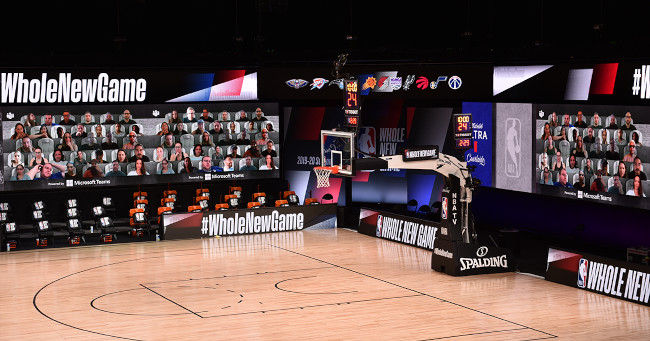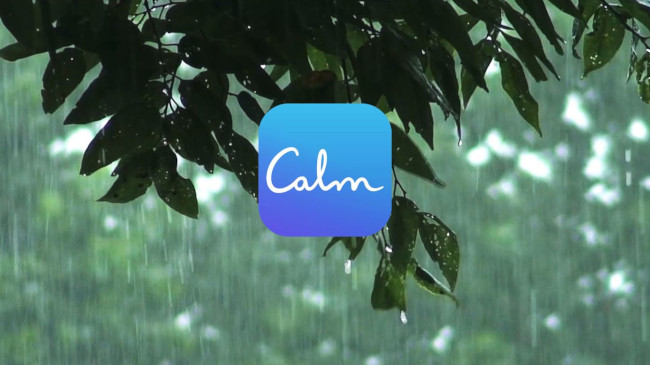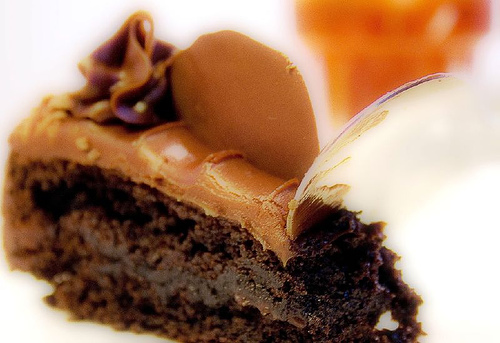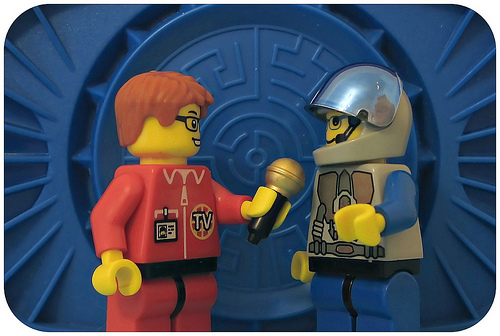Shortly after the announcement that Prince Harry and Meghan Markle were "stepping away" as senior members of the Royal Family, Madame Tussauds Wax Museum also made news by removing Harry and Megan from a wax display of the Royal family.

But, the famous wax museum's publicity stunt isn't the only example of a brand that's leveraged a news event to gain awareness or viral attention. In fact, this tactic has been used by marketers throughout the 2000s. It's often called "newsjacking."
Newsjacking is when a brand or firm mentions or creates a campaign centered around a major, well-discussed news item. It's slightly different from a publicity stunt in that the news item is leveraged in marketing while a stunt might acknowledge news within a public venue or place of business.
Why do brands choose to newsjack rather than creating a totally original storyline for their campaigns? It's simply because this strategy helps them get discovered by adding or piggybacking off of larger conversations happening online.
In the early 2010s, we frequently saw newsjacking attempts during big, televised events like the Super Bowl or the Academy Awards. But, as marketers more frequently use social media and online channels, we're seeing brands identify newsy topics faster and newsjack through a variety of content.
If you're looking to leverage news, trends, or current events to amp up your marketing strategy, you might be wondering, "How do I get started?" or "How can I do this tastefully?"
If so, one great way to learn how to newsjack is to watch how other brands have done it.
Featured Resource: Newsjacking Blog Post Template
Prepare your blog team for newsjacking with these six free blog post templates, including a prompt and checklist specifically built for newsjacking.
Examples of Newsjacking
To help you get inspired, here are a few examples of brands that successfully took on newsjacking and some takeaways that you can keep in mind in 2021.
1. Google's Year in Search
2020 was a difficult year for many people, defined primarily by the global pandemic caused by novel virus COVID-19. The spread of COVID-19 led to a global health crisis, governmental shutdowns, and the worst economic recession since the Great Depression.
But 2020 also marked a contentious U.S. election amidst a civil rights movement, major climate catastrophes such as the fires in California and Australia, and deaths of prominent figures such as Kobe Bryant, Chadwick Boseman, Justice Ruth Bader Ginsburg, and Alex Trebek. With the challenges that 2020 brought, some thought the year would never end.
The Newsjacking
Every December, Google shares its #YearInSearch, featuring the trends and events that shaped the year. This video promotes Google's brand as well as its feature Google Trends, a tool that helps users review and analyze unbiased samples of Google search data.
Because of the unique events in 2020, #YearInSearch was a poignant recap that tackled the topics the swept the world. According to Fast Company, 2020's Year in Search campaign differed from previous years' campaigns in more than just content. "For starters, the 2020 Year In Search video is narrated with a poem written and spoken by poet Kofi Dadzie, a Ghanaian American based in Boston. The video also features an original song this year, instead of using a pre-existing one. That song is called 'Together' and was created by Grammy-winning producer Peter Cottontale, with collaboration from Cynthia Erivo and Chance the Rapper."
Google is drawing from the news in a macro way and connecting the year's stories to its product. Instead of highlighting search features or ad capabilities, Google leans more into the sentiment that we share when we take to the web: Our thirst for knowledge. Combining this sentiment with artistic contributions, Google is able to craft a compelling narrative that's not easily forgettable.
2. Aviation Gin's Rebuttal to Peloton
In December 2019, the workout bike company Peloton released a critically panned commercial that begins with a husband giving his wife a Peloton for Christmas. As the commercial continues to the optimistic sounds of the song, "There She Goes," the wife, coined as "Peloton Wife" on social media, films herself working out every day for a year. At the end of the ad, she shares the video with her husband -- seemingly the following Christmas.
Here's the commercial, which is titled"The Gift That Gives Back":
The commercial was heavily criticized and mocked throughout social media because it enforced dated gender norms and goes against body positivity because many people believe that a husband buying a wife a workout device insinuates that she's out of shape.
The Newsjacking
After the Peloton ad -- and it's instant criticisms -- circulated the internet, actor and Aviation American Gin owner Ryan Reynolds immediately cast Monica Ruiz, a.k.a. "Peloton Wife," in a commercial written to feel like a sequel to the Peloton ad. In the commercial, humorously titled "The Gift That Doesn't Give Back," Ruiz sits at a bar, staring blankly into the camera. She emotionlessly sips on and complements the smooth taste of Aviation Gin as her supportive friends offer her more gin and make comments like, "You look great, by the way."
While the ad doesn't directly mention the workout bike company, Reynolds says Aviation Gin's commercial was a direct response to Peloton. In fact, Reynolds initially tweeted the ad with the caption, "Exercise bike not included," and later explained that he hired the Ruiz just a "few hours" after the original ad launched.
"I've been there as an actor, where you do something that doesn't quite work . We got ahold of her and within 36 hours, we shot, chopped, and put out this commercial," Reynolds explained on The Tonight Show.
Shortly after its launch, Aviation Gin's commercial went viral, receiving over 7.2 million YouTube views and 55.6 thousand retweets on Twitter. It's also been noted by a number of publications including MarketingLand and AdWeek.
This newsjacking was successful for a number of reasons. First, the brand quickly responded to a news item with a creative idea. Additionally, the campaign was subtle, professional, and didn't directly acknowledge Peloton. With just a few words and visuals, it told a deeper story which was almost more hilarious than if it had directly acknowledged the workout bike company.
3. Burger King's "Big Mac-ish" Menu
After a legal battle with an Irish fast-food chain called Supermac's, McDonalds lost its exclusive Big Mac trademark. While the fast-food giant could still keep using the Big Mac title for its sandwich in Europe, the ruling noted that any other company could also use the term "Big Mac" on its menus or marketing assets.
The Newsjacking
Burger King took full advantage of its competitor's legal slip by launching a handful of marketing content discussing its own Big Mac-like products.
For example, Burger King released European menus that promoted its own "Big Mac-ish" sandwiches, as seen below. It also offered a limited-time flame-grilled Big Mac that it claimed was bigger and tastier than the McDonald's menu item.
Below is the Burger King menu which highlights its Big Mac-ish items and the Big Mac copy.

This is a great example of how one company can take advantage of news relating to its competitor in a funny, but professional way.
4. Microsoft Teams's Deal With the NBA
COVID-19 stalled the sporting world as many local governments shut down and health organizations recommended social distancing. Sports organizations were faced with a challenging pivot in order to abide by these guidelines and keep athletes and audiences safe. Fans were left wondering how this shift would affect the sports they knew and loved.
When it became clear that many sports organizations would commence their seasons with zero or reduced fan attendance, the question become how it would affect the experience for both fans watching at home and the players on the court or field. After all, players feed on the energy of their environment, and sports is just as much a mental game as a physical one.
The Newsjacking
Microsoft Teams saw this situation as an opportunity to promote its "Together Mode" feature, which pulls virtual participants out of the boxy digital screens and into a "virtual reality" where they're together. By partnering with the NBA, Microsoft Teams was able to simulate the experience of a crowd in the stands with virtual attendees.

The effect was a sense of community for both audiences and players despite its digital execution. And Microsoft was able to benefit from the showcasing of its product (in an innovative way) to NBA's audience.
5. AeroMexico's "A World Without Borders"
Throughout President Donald Trump's time in office, the administration has tightened border policies while continuing to construct a metal wall at the U.S. Mexico border. This has continued to fuel debates about whether the United States, a country that was historically founded by immigrants, should have such tight border policies and a wall.
This debate reached a head when the Trump administration's request for wall funding resulted in the longest government shutdown ever, running from December 22, 2018, to January 25, 2019.
The Newsjacking
AeroMexico, an airline that offers routes specifically to Mexico, paid close attention to these debates and took note of the fact that millions of Americans "did not want to travel to Mexico."
Rather than pivoting their strategy or adding routes to other locations, AeroMexico went to a rural United States town, DNA-tested residents who were in favor of the border wall, and offered them flight discounts based on the percentage of Mexican descent that was revealed on their DNA tests.
AeroMexico then followed up with a commercial showing each person giving their views on immigration laws, Mexico, and the wall.
During the commercial, which showed AeroMexico interviewing the residents, a cameraman asks each of them, "Would you consider going to Mexico?" Their discomfort with the idea of traveling south becomes apparent when they answer with statements like, "No way!" and "Let those folks stay on their side of the border."
It then showed their surprised facial expressions when they all found out about their Mexican heritage. Lastly, the commercial notes how most of them were interested in taking the discounted flight to Mexico once they were offered it.
"Many Americans don't like Mexico. But … according to the U.S. Department of Homeland Security, Mexican immigration goes as far as the 1800s, settling in on the south -- meaning that a big percentage of descendants in the U.S.A. don't even know it yet," noted AeroMexico's Clio award submission.
"Without a significant budget, our strategy was to take advantage of the media coverage that President Trump's government shutdown had. Therefore, we focused all of our PR resources on spreading our video on social media," the submission added.
According to the Clio submission, the campaign went viral, receiving more than 1.6 billion impressions. It also resulted in a 33.7% increase in ticket sales between the U.S. and Mexico.
This campaign and commercial is a great example of how a company entered a political debate and made a point in a clever way. It also shows that they are proud of their business and those of the Mexican heritage because they're willing to offer giant discounts, even to immigration critics, with Mexican descent.
The commercial and campaign were so fascinating and thought-provoking that it even won a 2019 Clio Award.
6. Calm's Election Ads
Emotionally draining news cycles that include contentious elections are not ideal conditions for advertising, which often aims to create positive sentiment and association.
The Newsjacking
Viewers across the U.S. watched CNN's election coverage, which was sponsored by Calm, a meditation app. In addition to its sponsorship, Calm ran several 30-second ads leading up to and on Election Night.
Calm's mission is to "make the world happier and healthier," and what better way to do that position its product during a time where people are feeling anxious?
Calm didn't use any election messaging in this campaign campaign, instead showing calming ads which served as a stark juxtaposition to the end of a stressful election season.

According to Katie Shill, Senior Director of Brand Marketing at Calm, in an interview with Ad Age, the campaign was successful. "We saw positive ROI on TV, a really big spike of organic growth that's really sustained since the election night, and a ton of social conversation and PR coverage, too." She continues to say that it was "a super smart media buy that sparked social conversation that also sparked an amazing wave of PR. We showed up at the right time with the right message, and it paid off."
7. Gillette's "The Best Men Can Be"
In 2018 and 2019, the #MeToo movement led to a number of high-powered, and sometimes well-trusted, men getting accused or charged for sexual assault and harassment. High-level men who incurred allegations included film executive Harvey Weinstein and ex-Good Morning America co-host Matt Lauer.
This movement was marked by the #MeToo social media trend, started by civil rights activist Tarana Burke. The movement encouraged women to spread awareness of how common sexual harassment, misconduct, and assault was by sharing stories along with the #MeToo hashtag.
The Newsjacking
Gillette, which has always positioned its shaving products as, "The Best a Man Can Get," wanted to reposition its take on masculinity in light of the #MeToo movement. To do this, they aired an intense Super Bowl commercial that digs into toxic masculinity and the negative stereotypes related to manhood.
The commercial begins with visuals of men looking in the mirror, with soundbites of news reports related to bullying, toxic masculinity, and the #MeToo movement. When the ad cuts to an old Gillette commercial showing a strong man, a narrator asks, "Is this really the best a man can get?" as a young boy breaks through a screen showing the old Gillette commercial while running from bigger male bullies.
The commercial goes on to show different aspects of toxic masculinity, such as texts from male bullies saying phrases like "FREAK!", a male executive touching a woman's shoulder in a meeting and stating, "What I think she's trying to say is…", and young children fighting as their father's say, "Boys will be boys."
Suddenly, the narration says, "Something finally changed -- and there will be no going back," as the ad cuts to clips of news coverage following the #MeToo movement.
The ad culminates by showing clips of men being good influences by stopping boys from fighting, standing up to bullies, and actual footage of a father telling his infant daughter that she is strong.
"We believe in the best in men. To say the right thing, to act the right way. Some already are in ways big and small. But 'some' is not enough. Because the boys watching today will be the men of tomorrow," the ad concludes.
While the commercial highlighted a controversial item and allowed the company to take a progressive stance on it, it still came with some mixed reviews due to its sensitive nature. Although it has both positive and negative reviews, it's important to include on this list so that marketers can learn both the positive and impacts of newsjacking strategies.
Many who saw the ad felt that Gillette was desperately leaning into a sensitive movement to benefit its own brand.
"Part of the Gillette’s motive for running the ad may be that there is recent research suggesting that millennials give more credit to brands using corporate social responsibility appeals," noted a Forbes post. "In this case, it appears Gillette will learn a lesson about what not to do as pertains to corporate responsibility efforts."
Meanwhile, some still identified how it was a solid step forward in marketing.
For example, a Wired post noted that the ad was an "undeniable sign of progress" despite its backlash.
"Once again, the country seems divided. This time, it’s not a border wall or a health care proposal driving the animus, but an online ad for a men’s razor, because, of course," the Wired article states. "But underneath the controversy lies something much more important: signs of real change."
All in all, it's important to look at both the pros and cons of this example. Although Gillette's commercial was high quality, made valid points, and stirred emotions from viewers, it's important to keep in mind that this is a large company still aiming to succeed in a society that is much different than when its company began decades ago.
8. Oreo's Area 51 Tweet
In the fall of 2019, social media users were buzzing about a bizarre plan to raid Area 51, a highly classified government base which conspiracy theorists say is the home of testing extraterrestrials.
The Newsjacking
Oreo went to Twitter and simply joked, "What flavors do you think they're hiding in #Area51?" Thousands of users, and even other brands, replied and shared the tweet.

This is a great example of a brand that affordably, and quickly, referenced newsy or trendy topics to gain engagement, likeability, and brand awareness on a social network. Not to mention, Oreo instantly got people to discuss great Oreo flavors on Twitter.
While other brands on this list have embraced newsjacking with high-budget campaigns or commercials, Oreo shows that the strategy doesn't have to get too complex, time-consuming, or costly for marketers.
Newsjacking Takeaways for 2022
With fast-paced social media and online news published every second, there are more and more opportunities where marketers can embrace newsjacking.
But, before you attempt to newsjack, take time to consider the news item and make sure that your strategy will be tasteful or informative, rather than offensive. For example, if you make a funny reference about a bizarre trend like the Area 51 raids, you might be seen as funny or memorable. However, if you post an insensitive campaign or comment about a controversial topic -- such as immigration, you might be seen as out of touch.
As you craft a creative newsjacking strategy, be sure to run it by other members of your marketing team and get your feedback to ensure that your content doesn't flop.
Editor's note: This post was originally published in February 2020 and has been updated for comprehensiveness.




